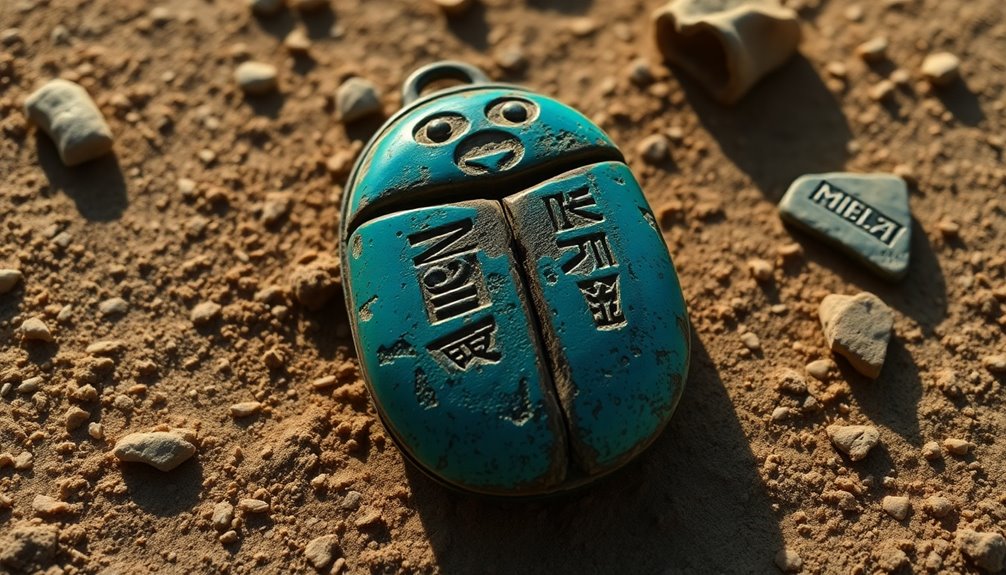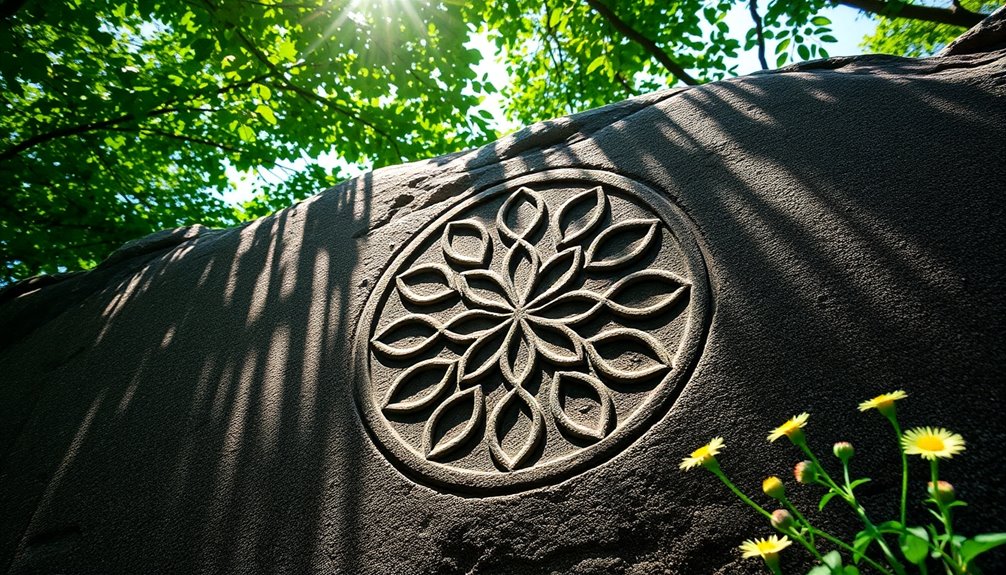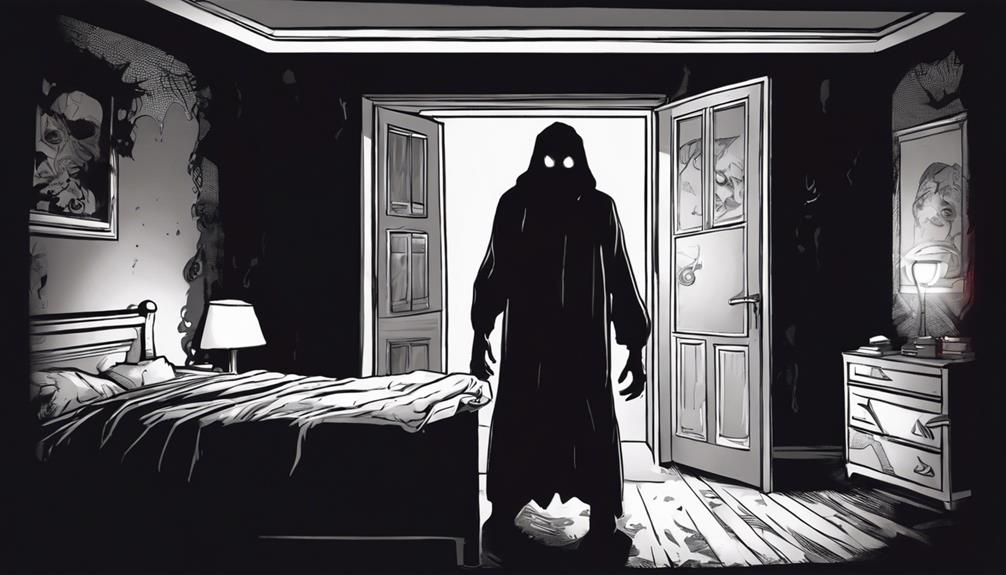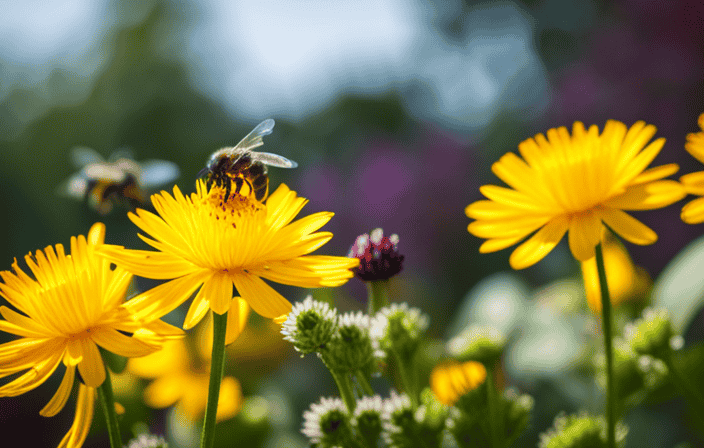The scarab's meaning in ancient Egypt goes beyond a simple symbol of transformation and rebirth. You might not realize its role in funerary practices, where heart scarabs, inscribed with spells, were placed on mummies' chests to guarantee protection in the afterlife. These artifacts reveal deeper insights into societal values and religious beliefs. Crafted from materials like glazed steatite and lapis lazuli, they showcase exquisite artistry. However, the darker secrets tied to their use and significance in rituals hint at complex beliefs about life and death. There's so much more to uncover about this intriguing symbol of ancient Egyptian culture.
Key Takeaways
- Scarabs symbolize transformation and rebirth in ancient Egyptian culture, reflecting deep spiritual beliefs about life and the afterlife.
- Heart scarabs, inscribed with protective spells, were crucial for safe passage during the judgment of the heart rite.
- Funerary scarabs were placed in tombs to ensure resurrection and protection, revealing practices surrounding death and burial.
- The craftsmanship of scarabs, using precious materials, highlights artisans' skills and the cultural emphasis on the afterlife.
- Archaeological findings, such as those in Tutankhamun's tomb, unveil trade networks and societal values tied to scarab symbolism.
Historical Significance of Scarabs
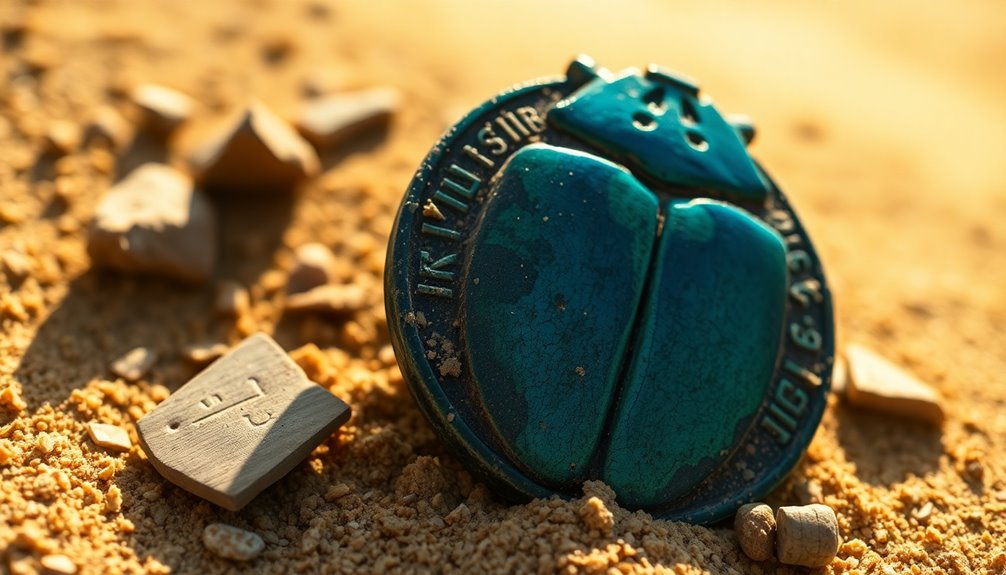
The scarab beetle, a symbol of transformation and rebirth, played an essential role in ancient Egyptian culture, especially during the late Old Kingdom. Scarabs emerged around 2575–2130 BCE, evolving from simple button seals into complex designs that reflected their growing significance.
You'd find scarabs placed in tombs as protective amulets, symbolizing resurrection and a safe passage to the afterlife. This belief underscored the importance of funerary practices in ensuring a smooth changeover to what lay beyond.
Heart scarabs had a particularly significant role, inscribed with spells to protect the deceased during the judgment of the heart rite. This rite was critical for determining one's fate in the afterlife, highlighting the cultural significance of these artifacts.
Archaeological findings, like those uncovered in Tutankhamun's tomb, reveal not just their spiritual importance but also insights into ancient Egyptian trade networks. The names of pharaohs, queens, and other important figures inscribed on scarabs reflect societal values and beliefs about the afterlife.
Scarabs, consequently, weren't merely decorative; they were deeply woven into the fabric of ancient Egyptian life and death, embodying a rich tapestry of cultural significance.
Types of Scarabs and Their Uses
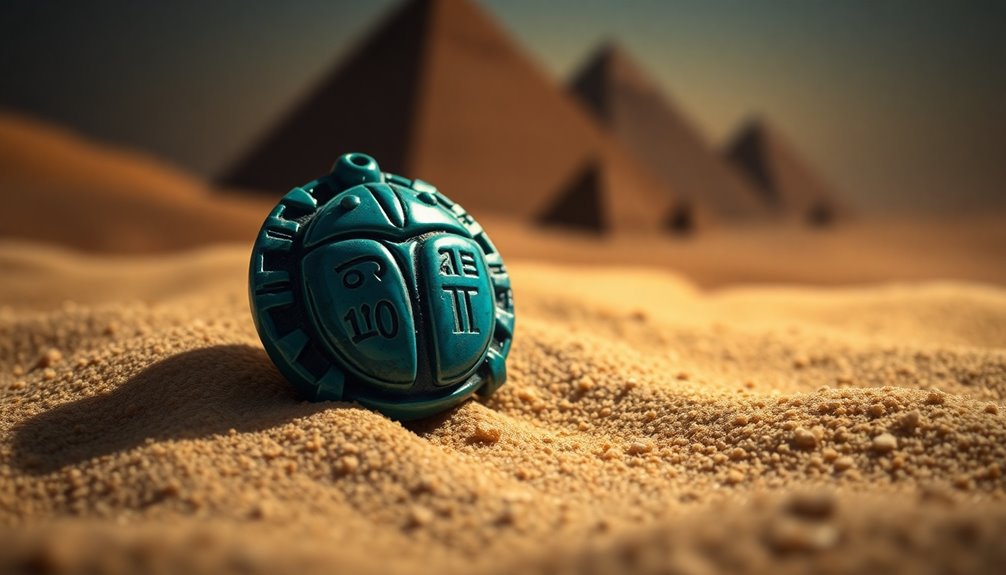
Scarab served various purposes in ancient Egypt, each type reflecting different aspects of culture and belief. Among the most notable types are:
- Heart Scarabs: Placed directly on mummies' chests, these amulets protected the heart during judgment.
- Funerary Scarabs: Commonly found in tombs, these scarabs guaranteed safe passage to the afterlife, often inscribed with spells related to the weighing of the heart rite.
- Commemorative Scarabs: Commissioned during Amenhotep III's reign, these pieces detailed significant events and served as both propaganda and gifts.
- Scarab Seals: Used as official seals, these scaraboid seals reflected ownership and social status, often carved from steatite or faience.
- Ornamental Scarabs: Featuring intricate designs, these decorative pieces celebrated the beauty of dung beetles and the life cycle they represented.
Each scarab played an essential role in Egyptian history, from aiding the mummification process to marking personal and royal achievements.
These varied uses highlight how deeply scarabs were woven into the fabric of ancient Egyptian life, serving not just as symbols, but practical tools for protection and remembrance.
Materials and Craftsmanship Techniques
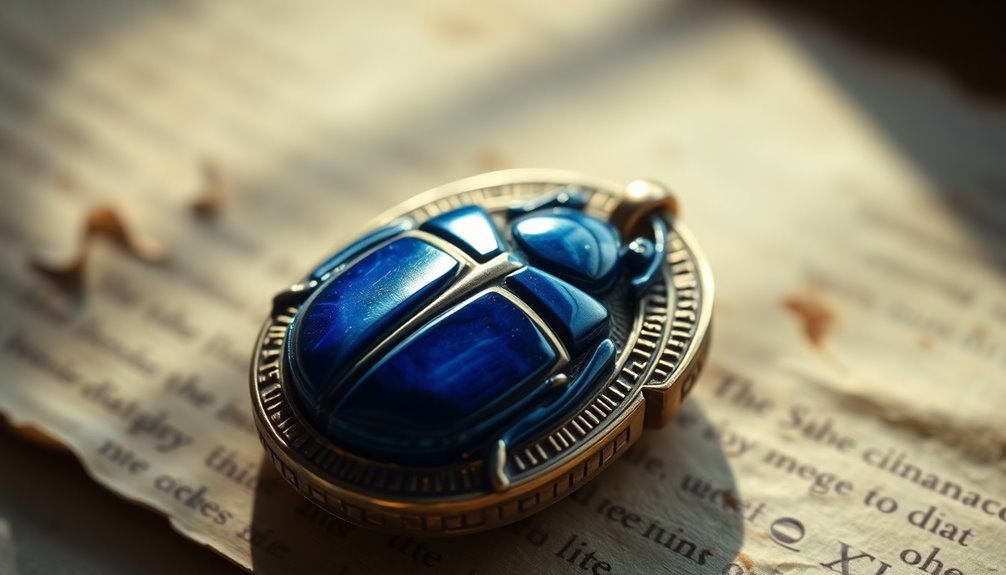
Crafted from a variety of materials, ancient Egyptian scarabs showcase the artisans' skill and the resources available at the time. Scarabs were made primarily from glazed steatite, faience, and hardstones like carnelian, lapis lazuli, and green jasper. This range of materials allowed for both personal and ceremonial uses, with sizes typically between 6 mm and 40 mm.
The craftsmanship techniques employed in scarab production included carving, molding, and engraving. During the New Kingdom, artisans specialized in creating these intricate objects, demonstrating their artistic detail through complex designs. Many scarabs featured inscriptions, often adorned with hieroglyphs and symbolic imagery that conveyed protective spells.
Heart scarabs, which were larger and more elaborately crafted, were usually made from precious materials. These scarabs were inscribed with spells intended to protect the deceased's heart during the judgment in the afterlife, reflecting the deep spiritual significance attached to these artifacts.
The meticulous work put into each scarab highlights not just the artisans' craftsmanship but also the cultural values of ancient Egypt, where every detail served a purpose in both life and the afterlife.
Cultural Influence and Artistic Representations
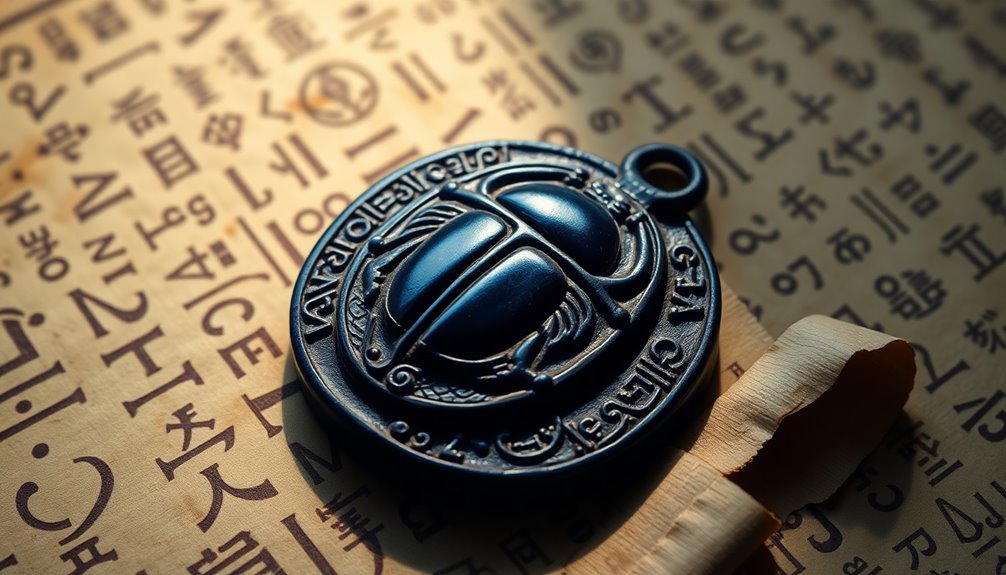
Ancient Egyptian scarabs hold a prominent place in the tapestry of cultural and artistic expressions. These iconic symbols not only represented rebirth and protection but also influenced a variety of artistic forms.
You'd see scarabs intricately carved in jewelry, vividly portrayed in tomb paintings, and adorned with hieroglyphs that conveyed profound cultural beliefs. Their artistic representations include:
- Exquisite gold jewelry showcasing scarab motifs
- Elaborate tomb paintings depicting scarabs in scenes of the afterlife
- Decorative elements in Ptolemaic period architecture
- Roman and Greek artifacts reflecting the scarab's significance
- M. C. Escher's wood engraving, illustrating modern interpretations
The cultural importance of scarabs transcended Egypt, evident in the cross-cultural exchange during the Canaanite and Phoenician periods. Artists blended Egyptian motifs with new designs, enriching their own artistic heritage.
The emergence of large scarab sculptures in public spaces during the Ptolemaic period further solidified their role as essential decorative elements. Scarabs symbolize a bridge between ancient Egyptian art and broader Mediterranean cultures, showcasing how deeply intertwined these artistic traditions are.
Archaeological Discoveries and Insights
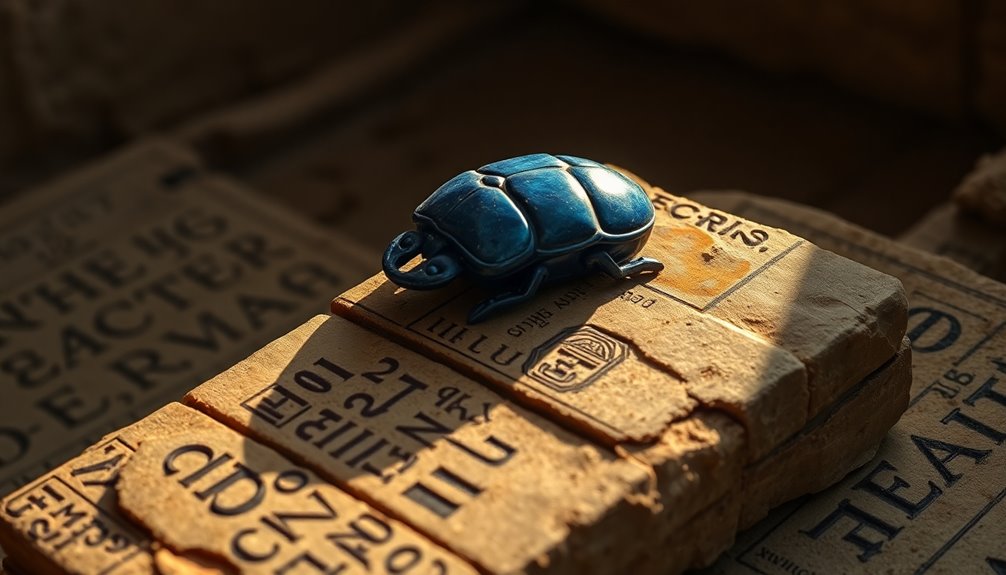
Archaeological discoveries in Egypt reveal intriguing insights into the significance of scarabs in ancient life. These findings showcase how scarabs played a vital role in the religious beliefs and burial practices of ancient Egyptians, emphasizing resurrection and protection in the afterlife.
Remarkably, heart scarabs were placed on mummies, inscribed with spells from the Book of the Dead, ensuring safe passage during the judgment of the deceased.
Among these treasures, the scarab inscribed with Nefertiti's name from the Uluburun shipwreck highlights the extensive trade networks and luxury goods prevalent during the Bronze Age. Additionally, excavations in the Valley of the Kings have uncovered numerous heart scarabs, which reflect the complex craftsmanship and social status of their owners during the New Kingdom.
Scarabs were mass-produced, varying in size and material, reinforcing their role as amulets for both the living and the dead. The widespread discovery of scarabs across different dynasties underlines their importance in ancient Egyptian culture, serving not only as protective symbols but also as essential components of burial practices.
Each find adds to our understanding of this enthralling civilization's beliefs and traditions.
Frequently Asked Questions
What Is the Scarab in Egyptian Burial?
In ancient Egypt, you'd find scarabs in burial practices, serving as protective amulets. These scarabs symbolized resurrection, ensuring a safe passage for the deceased into the afterlife.
You'd see heart scarabs placed on mummies' chests, inscribed with spells to protect against judgment. The scarab's rolling behavior mirrored the sun god Ra's journey, representing life, death, and rebirth.
They also indicated status, often engraved with names of pharaohs and important figures, reflecting their power.
Why Did the Ancient Egyptians Bury Their Dead With the Scarab Amulet Over Their Hearts?
Ancient Egyptians buried their dead with the scarab amulet over their hearts because they believed it offered protection and guaranteed rebirth in the afterlife.
You'd find these amulets inscribed with spells to prevent the heart from testifying against the deceased during judgment.
What Is the Spiritual Meaning of the Dead Scarab?
So, you think a dead beetle's just a bug, huh? Well, you're in for a surprise!
The dead scarab symbolizes transformation and rebirth. It embodies the belief that life's a cycle, constantly renewing itself.
Ancient Egyptians saw this little critter as a protector in the afterlife, ensuring safe passage for the deceased.
It's not just a creepy-crawly; it's a powerful emblem of regeneration, linking the living to the divine and the eternal.
Why Was a Scarab Beetle Buried With a Mummy?
You'll find that a scarab beetle was buried with a mummy to symbolize protection and rebirth.
This practice guaranteed the deceased's safe passage into the afterlife. Placing the scarab on the chest, often inscribed with spells from the Book of the Dead, safeguarded the heart during judgment.
The scarab, connected to the sun god Khepri, represented the cycle of life and regeneration, emphasizing its essential role in ancient Egyptian funerary customs.
Conclusion
In exploring the enchanting world of scarabs, you've uncovered their historical heft and hidden heritage. These small symbols of significance not only showcase stunning skill but also serve as a striking reminder of ancient Egyptian beliefs. From their fascinating forms to their fabulous finds in tombs, scarabs continue to spark curiosity and inspire intrigue. As you investigate deeper into their dark secrets, you'll discover a dazzling tapestry woven through time, waiting to be unraveled.
